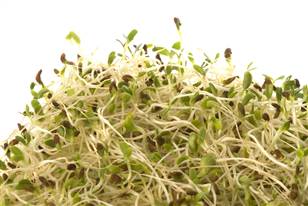現在位置 : 飲食 > 全球七大不安全食物:壽司被評為第一 (Seven Unsafe Food )
|
全球七大不安全食物:壽司被評為第一
美國 MSN網站公佈以下七種食品,在食用時一定要慎重。 (1)、壽司 (Sushi): 危險因素:壽司的最大問題是寄生蟲、扁形蟲和蛔蟲,例如生魚中的寄生蟲。雖然生魚不能保證安全,但是,蘸醬汁或者青芥可能會起到輕微的殺菌作用。解決辦法:魚至少在145度的高溫下烹調1分鐘,可殺死魚中的任何寄生蟲。 但是,那就不是壽司了。唯一可生吃魚又保證不攜帶寄生蟲的方法是吃用冷凍魚做成的壽司。 美國食品藥品管理局推薦在零下31度至少15小時可殺死死寄生蟲。 Sushi. Risk factors: the biggest problem is that of the sushi parasite, flatworms and roundworms, such as raw fish parasites. Although the raw fish can not guarantee security, but the dipping sauce or mustard green may play a minor role in sterilization. The solution: fish cooking in 145 degree heat at least 1 minute to kill any parasites in the fish. However, it is not sushi. The only raw fish to ensure they do not carry the parasite is eating sushi made with frozen fish. The U.S. Food and Drug Administration recommended that the frozen fish in temperatures of minus 31 degrees for at least 15 hours to kill parasites. (2)、雞蛋 (eggs): 危險因素:感染因數是在雞蛋裡,唯一根除細菌的方法就是將雞蛋煮熟。 解決辦法:不吃生雞蛋和半熟的雞蛋。蛋黃未凝固的雞蛋有潛在的危險。為了安全,你最好吃煮老一點的雞蛋或固體狀的雞蛋。高溫會殺死任何可能存在的細菌,你可放心吃水煮雞蛋或者兩面煎蛋。 Eggs. Risk factors: an infectious agent in the egg inside, the only way to eradicate bacteria is to cook the eggs. The solution: do not eat raw eggs and undercooked eggs. The egg yolk is not solidified is potentially dangerous. For security, you'd better eat cook the eggs of older eggs or solid form. The high temp will kill any bacteria that may exist, you can rest assured that eating boiled eggs or both sides of the omelette. (3)、牛肉餡 (ground beef or minced beef): 危險因素:吃生牛肉或者半熟牛肉都不利於健康。牛肉可能攜帶沙門氏菌或者大腸桿菌。牛肉餡比牛排更危險,因為它被用手握的可能性更大,絞成肉餡後,它的表面更大,藏匿細菌更多。 解決辦法:唯一能保證無菌的方法是購買經過殺菌處理的牛肉。 Ground beef. Risk factors: eating raw beef or half-cooked beef is not conducive to health. Beef may carry salmonella or E. coli. Ground beef steak is more dangerous, because it was a hand is more likely, the mountain of meat, the greater its surface, hiding the bacteria more. The solution: The only way to ensure aseptic method is to buy after sterilization processing beef. (4)、包裝好的綠色蔬菜 (packaged green vegetables): 危險因素:包括萵苣和菠菜在內的葉狀綠色蔬菜,一直是近年來幾種疾病暴發的“罪魁禍首”。其中規模最大的疾病暴發之一是2006年的大腸桿菌,與成包的菠菜有關,導致199人患病,3人死亡。 大腸桿菌和沙門氏菌感染農產品的方法多樣,動物糞便滲透到水中或者土壤中,或者手工採摘,或者包裝過程中傳染。大多數情況下,水並不能洗掉這些危險。 解決辦法:捲心菜外面的葉子更可能被污染,因此,摘掉葉子,洗手,然後再準備其餘的部分。 Packed green vegetables. Risk factors: leafy green vegetables, including lettuce and spinach have been several disease outbreaks in recent years, the "culprit". One of the largest disease outbreaks outbreaks of E. coli in 2006, and the spinach into a package, resulting in 199 people get sick, three people were killed. (5)、芽菜 (sprouts) : 危險因素:芽菜生長的環境最利於有害細菌的滋生。 解決辦法:唯一能保證安全的方法是烹調專家建議:將芽菜投入湯鍋或大火煸炒。 Sprouts. Risk factors: the bean sprouts and growth of the environment most conducive to the breeding of harmful bacteria. The solution: the only way to ensure the safety is cooking. The bean sprouts should put into the soup pot or stir fried. (6)、生雞肉 (raw chicken) : 危險因素:生雞肉包含沙門氏菌和彎曲桿菌。最大的風險因素不是吃雞肉,而是在準備做雞肉時被交叉感染。 解決辦法:處理生雞肉時要特別小心:切過肉後要立即洗乾淨刀、菜板、灶台和手,避免雞肉內細菌傳播到其他食品。你將雞肉拿到外面放到烤架上時,要將用過的盤子拿回來,吃烤好的雞肉時要換新盤子。 Raw chicken. Risk factors: raw chicken contains salmonella and campylobacter. The biggest risk factor was not to eat chicken, but when you are ready to do the chicken cross infection. The solution: be particularly careful when handling raw chicken. After cutting through the meat must immediately wash the clean knife, cutting board, and your hands to avoid the dissemination of bacteria to other foods. Your chicken to get out on the grill, you want to used the plate to get it back, eat grilled chicken to a new plate. (7)、哈密瓜 (cantaloupe): 危險因素:表皮上有很多裂縫,易受細菌污染。哈密瓜的皮內可能存在細菌,一旦將瓜切開,這些細菌就會跑到瓜瓤內。 解決辦法:吃前先清洗瓜皮也能消滅一部分細菌,但是這些都不是最好的解決辦法。你必須小心儲存切開的哈密瓜,因為在室溫下會有大量細菌滋生。因此要將切開的水果放冰箱內。 Cantaloupe. Risk factors: there are many cracks on the skin vulnerable to bacterial contamination. May exist within the melon's skin bacteria, once the melon cut, these bacteria will went to the flesh. The solution: washing melons before eating can destroy part of the bacteria, but these are not the best solution. You must be careful to store cut melon. Put the cut fruit in the fridge. |
|
▼ 美國十項最不安全食物
The 10 Riskiest Foods in America Leafy greens top the list of FDA-regulated foods that can make you ill ----- From Food Safety on msnbc.com U.S. consumers have been bombarded with reports of contaminated food in recent years, from salmonella in peanut butter and spinach to E. coli in cookie dough and ground beef. Individually, the outbreaks are alarming, but collectively, they represent what the consumers' group Center for Science in the Public Interest calls "a perfect storm of unsafe food." A new CSPI report finds that the top 10 riskiest foods regulated by the federal Food and Drug Administration accounted for nearly 40 percent of all foodborne outbreaks in the U.S. between 1990 and 2006, spawning nearly 50,000 illnesses with symptoms ranging from stomach cramps and diarrhea to kidney failure and death. Using data from the Centers for Disease Control and Prevention, researchers tracked more than 1,500 separate, definable outbreaks involving not only high-risk foods like meat and dairy, but staples of a healthy diet, such as fruits and vegetables. These outbreaks are only the tip of the iceberg of foodborne illness. For every case of salmonella poisoning reported, the CDC estimates that another 38 cases go unreported. (1) Leafy greens Can salad really be bad for you? Although considered a healthy food, nutritious greens can also be coated in disease-causing germs. The Center for Science in the Public Interest identified 363 separate outbreaks linked to leafy greens, making them the No. 1 entry on the top 10 list of riskiest FDA-regulated foods. Salads and other food items containing leafy greens — iceberg lettuce, romaine lettuce, leaf lettuce, butter lettuce, baby leaf lettuce, escarole, endive, spring mix, spinach, cabbage, kale, arugula or chard — accounted for 24 percent of the outbreaks, which sickened at least 13,568 people. Another pathogen appearing frequently in leafy greens is norovirus, which was linked to 64 percent of the outbreaks in leafy greens. Salmonella was responsible for another 10 percent. Contamination may be present from production and processing or through improper handling, such as inadequate handwashing. (2) Eggs Eggs, a popular high-protein breakfast food, have been linked to 352 outbreaks. The majority of illnesses from eggs are associated with salmonella, which sickened 11,163 people from 1990 to 2006. Salmonella lives in the intestinal tracts of animals and birds and is transmitted to humans when animal feces contaminate a food item of animal origin (such as eggs). Regulations implemented in the 1970s have reduced salmonellosis infections. However, salmonella enteritidis, the most prevalent type of salmonella in eggs today, infects the ovaries of otherwise healthy hens and contaminates the eggs before the shells are formed. New regulations issued in July 2009 require the adoption of controls aimed at minimizing salmonella enteriditis in egg production. While proper cooking should destroy most pathogens, serving eggs raw – or "runny" – or leaving egg dishes at improper holding temperatures can allow the salmonella to multiply. (3) Tuna : (鮪魚) Many consumers are familiar with warnings about tuna and methylmercury, but the fish has also been implicated in 268 outbreaks and 2,341 reported cases of foodborne illness. Tuna has been linked to scombroid, the illness caused by scombrotoxin. Fresh fish decay quickly after being caught and, if stored improperly, begin to release natural toxins that are dangerous for humans. Adequate refrigeration and handling can slow this spoilage, but the toxin cannot be destroyed by cooking. Symptoms of scombroid poisoning can include skin flushing, headaches, abdominal cramps, nausea, diarrhea, palpitations and loss of vision. In addition to scombrotoxin, norovirus and salmonella can also be related to tuna consumption. More than 65 percent of outbreaks linked to tuna occurred in restaurants. (4) Oysters : (牡蠣) Contaminated oysters can ruin more than just a gourmet dinner. Oysters have been linked to 132 outbreaks, with 3,409 reported cases of illness. Not surprisingly, the majority of outbreaks from oysters occurred in restaurants. Illnesses from oysters occur primarily from two sources: norovirus and vibrio. Although norovirus in other foods is usually associated with improper handling, oysters actually can be harvested from waters contaminated with norovirus. When served raw or undercooked, those oysters can cause gastroenteritis, an inflammation of the stomach and small or large intestines. Vibrio, a type of bacterium in the same family as cholera, can cause a severe illness, particularly in those with a compromised immune system, characterized by fever and chills, septic shock and blistering skin lesions and can even be fatal. (5) Potatoes Potatoes, often in the form of potato salad, were linked to 108 outbreaks, with 3,659 consumers reported to have been sickened by spuds since 1990. Salmonella is the most common pathogen, associated with nearly 30 percent of outbreaks, followed by E. coli at 6 percent. The presence of salmonella and E. coli in potato dishes could indicate cross-contamination from raw or cooked ingredients or possibly from raw meat or poultry during handling and preparation. Shigella and listeria also appear in outbreaks associated with potatoes. More than 40 percent of potato outbreaks were linked to foods prepared in restaurants and food establishments. (6) Cheese (乾酪,奶酪) Cheese has been linked to 83 outbreaks involving 2,761 reported cases of illness since 1990, with salmonella the most common hazard. Cheese can become contaminated with pathogens during production or processing. Most cheeses are now made with pasteurized milk, lowering the risk of contamination. In August, California officials warned consumers about eating Latin American-style cheeses such as queso fresco or queso Oaxaca, which may be made by unlicensed manufacturers using unpasteurized milk that could contain harmful bacteria. Pregnant women should be particularly cautious about consumption of soft cheeses such as feta, brie, camembert, blue-veined and Mexican-style cheese, which can carry listeria. Listeriosis infection can lead to miscarriage. For the elderly, listeria can cause severe illnesses, with high rates of hospitalization and death. (7) Ice Cream Whether served in a cone or in a cup, America's favorite frozen treat occasionally can carry a load of dangerous bacteria. Ice cream has been linked to 74 outbreaks involving 2,594 reported cases of illness from pathogens such as salmonella and staphylcoccus since 1990. Soft ice cream can be particularly hazardous to pregnant women. Listeria can survive on metal surfaces — such as the interior of soft ice cream machines — and may contaminate batch after batch of products. (8) Tomatoes (番茄) Although tomatoes were wrongly implicated in a sweeping 2008 outbreak later linked to fresh jalapeno and Serrano peppers, they have caused at least 31 identified outbreaks and sickened 3,292 since 1990. The most common hazard associated with tomatoes is salmonella, which accounted for more than half of the reported outbreaks. Salmonella can enter tomato plants through the roots or flowers and can enter the tomato fruit through small cracks in the skin, the stem scar or the plant itself. Restaurants were responsible for 70 percent of all illnesses associated with tomatoes. (9) Sprouts (豆芽菜) Sprouts are a popular way to add crunch to salads and in Asian dishes. As the popularity of sprouts increases, however, so too does the potential for foodborne illnesses. Sprouts have been implicated in 31 outbreaks involving 2,022 reported cases of illness since 1990. The CDC and the FDA recommended in 1999 that people at high risk for complications from salmonella and E. coli — such as the elderly, young children, and those with compromised immune systems — not eat raw sprouts. The most likely source of sprout contamination is the seeds that are used to grow the sprouts. Seeds may become contaminated in the field or during storage, and the warm and humid conditions required to grow sprouts are ideal for the rapid growth of bacteria. (10) Berries Strawberries, raspberries, blackberries and other berry products have caused 25 outbreaks and sickened 3,397 since 1990. In 1997, more than 2.6 million pounds of contaminated strawberries were recalled after thousands of students across several states reported illnesses from eating frozen strawberries in their school lunches. Hepatitis A was the culprit, and contamination may have occurred through an infected farm worker, according to the CSPI report. That same year, raspberries imported from Guatemala and Chile were implicated in a cyclospora outbreak across five states. The resulting infection is a parasitic illness of the intestines, which can cause severe diarrhea, dehydration and stomach cramps and requires treatment with antibiotics. — Center for Science in the Public Interest |
▼ 美國十項最不安全食物
|

















